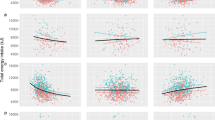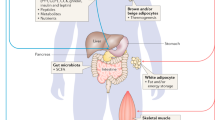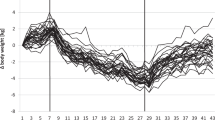Abstract
OBJECTIVE: To determine the influence of age on the ability to adjust macronutrient oxidation to changes in diet composition. Our hypothesis was that the ability to adjust macronutrient oxidation to changes in diet composition would be impaired with age.
DESIGN: Cross-sectional, randomized to three different isocaloric diets containing a constant percentage protein but varying in percentage fat and percentage carbohydrate: mixed diet (M; 15/30/55); high-fat diet (HF; 15/60/25), and high-carbohydrate (HC; 15/15/70).
SUBJECTS: Six young (YM; age=25±1 y) and five middle-aged and older men (OM; age=63±3 y).
MEASUREMENTS: Each subject underwent 24 h whole-room calorimetry on day 4 of each diet to determine 24 h macronutrient oxidation rates. Macronutrient balance was calculated from the individual macronutrient oxidation rates and the corresponding macronutrient intake.
RESULTS: Body mass, percentage fat, and fat-free mass were similar in the two groups. Twenty-four-hour energy expenditure (EE) and energy balance did not differ across diets or between groups; 24 h EE was ∼7% lower (NS) in the OM. Macronutrient oxidation rates were not significantly different in YM vs OM during M. Protein oxidation was similar across diets, but higher (P<0.05) in OM. Fat oxidation contributed 28.8±7.0% vs 37.8±4.7% to 24 h EE on M (NS) in the OM vs YM, respectively. This increased to 58.4±6.7 vs 51.9±5.3% of 24 h EE (NS) in the OM vs YM, respectively, during HF and decreased to 25.4±9.7 vs 20.2±14.3% (NS) during HC (diet effect, both P<0.05). Carbohydrate oxidation contributed 54.3±10.5% vs 56.6±2.4% of 24 h EE (NS) on M in the OM vs YM, respectively. This decreased to 19.5±10.6 vs 29.9±12.6% (NS) during HF and increased to 53.6±12.3 vs 64.7±14.3% (NS) in the OM vs YM, respectively during HC (diet effect, P<0.05).
CONCLUSION: Taken together, these results suggest that the ability to adjust macronutrient oxidation to changes in diet composition is maintained in OM and, thus, is unlikely to contribute to the increased susceptibility to weight gain and obesity development that accompanies aging.
This is a preview of subscription content, access via your institution
Access options
Subscribe to this journal
Receive 12 print issues and online access
$259.00 per year
only $21.58 per issue
Buy this article
- Purchase on Springer Link
- Instant access to full article PDF
Prices may be subject to local taxes which are calculated during checkout




Similar content being viewed by others
References
Durnin JVGA, Womersly J . Body fat assessed from total body density and its estimation from skinfold thickness: measurements on 481 men and women aged from 16 to 72 y Br J Nutr 1974 32: 77–97.
Going S, WDLT, HM . Aging, body composition, and physical activity: a review J Aging Phys Act 1994 2: 38–66.
Steen B . Body composition and aging Nutr Rev 1988 46: 45.
Flegal KM, Carroll MD, Kuczmarski RJ, Johnson CL . Overweight and obesity in the United States: prevalence and trends, 1960-1994 Int J Obes Relat Metab Disord 1998 22: 39–47.
Kuczmarski R, Flegal K, Campbell S, Johnson C . Increasing prevalence of overweight among US adults: the national health and nutrition examination surveys, 1960 to 1991 JAMA 1994 272: 205–211.
Seidell J, Muller D, Sorkin J, Andres R . Fasting respiratory exchange ratio and resting metabolic rate as predictors of weight gain: the Baltimore Longitudinal Study on Aging Int J Obes Relat Metab Disord 1992 16: 667–674.
Zurlo F, Lillioja S, Puente AED, Nyomba B, Raz I, Saad M, Swinburn B, Knowler W, Borgardus C, Ravussin E . Low ratio of fat to carbohydrate oxidation as predictor of weight gain: study of 24-h RQ Am J Physiol 1990 259: E650–E657.
Hill J, Peters J, Reed G, Schlundt D, Sharp T, Greene H . Nutrient balance in man: effects of diet composition Am J Clin Nutr 1991 54: 10–17.
Lean M, James W . Metabolic effects of isoenergetic nutrition exchange over 24-hours in relation to obesity in women Int J Obes 1988 12: 15–27.
Schrauwen P, Lichtenblet WvM, Saris W, Westerterp K . Changes in fat oxidation in response to a high-fat diet Am J Clin Nutr 1997 66: 276–282.
Horton T, Drougas H, Brachey A, Reed G, Peters J, Hill J . Fat and carbohydrate overfeeding in humans: different effects on energy storage Am J Clin Nutr 1995 62: 19–29.
Horton T, Drougas H, Sharp T, Marinez L, Reed G, Hill J . Energy balance in endurance-trained female cyclists and untrained controls J Appl Physiol 1994 76: 1937–1945.
Sharp T, Reed G, Sun M, Abumrad N, Hill J . Relationship between aerobic fitness and daily energy expenditure in weight stable humans Am J Physiol 1992 263.
Thomas C, Peters J, Reed G, Abumrad N, Sum M, Hill J . Nutrient balance and energy expenditure during ad libitum feeding of high-fat and high-carbohydrate diets in humans Am J Clin Nutr 1992 55: 934–942.
Jacquier E, Acheson K, Schutz Y . Assessment of energy expenditure and fuel utilization in man Ann Rev Nutr 1987 7: 187–208.
Bergman R, Beard J, Chen M . The minimal modeling method. Assessment of insulin sensitivity and β-cell function in vivo. In: Clarke W, Larner J, Pohl S (eds). Methods in diabetes research, vol II: clinical methods John Wiley: New York 1986 15–34.
Roberts SB . Effects of aging on energy requirements and the control of food intake in men J Gerontol A Biol Sci Med Sci 1995 50: (Suppl): 101–106.
Roberts SB, Fuss P, Heyman MB, Young VR . Influence of age on energy requirements Am J Clin Nutr 1995 62: 1053S–1058S.
Roberts S, Fuss P, Heyman M, Evans W, Tsay R, Rasmussen H, Fiatarone M, Cortiella J, Dallal G, Young V . Control of food intake in older men JAMA 1995 272: 1601–1606.
Calles-Escandon J, Arciero P, Gardner A, Bauman C, Poehlman E . Basal fat oxidation decreases with aging in women J Appl Physiol 1995 78: 266–271.
Calles-Escandon J, Poehlman E . Aging, fat oxidation, and exercise Aging Clin Exp Res 1997 9: 57–63.
Toth M, Arciero P, Gardner A, Calles-Escandon J, Poehlman E . Rates of free fatty acid appearance and fat oxidation in healthy younger and older men J Appl Physiol 1996 80: 506–511.
Melanson K, Saltzman E, Russell R, Roberts S . Fat oxidation in response to four graded energy challenges in young and older women Am J Clin Nutr 1997 66: 860–866.
Sial S, Coggan AR, Carroll R, Goodwin J, Klein S . Fat and carbohydrate metabolism during exercise in elderly and young subjects Am J Physiol 1996 271: E983–989.
Campbell W, Crim M, Dallal G, Young V, Evans W . Increased protein requirements in the elderly: new data and retrospective reassessments Am J Clin Nutr 1997 60: 501–509.
Campbell W, Evans W . Protein requirements of elderly people Eur J Clin Nutr 1996 50: S180–S185.
Beaufrere B, Boirie Y . Aging and protein metabolism Curr Opin Clin Nutr Metab Care 1998 1: 85–89.
Milward D, Roberts S . Protein requirements of older individuals Nutr Res Rev 1996 9: 67–87.
Acknowledgements
This work was supported by National Institute of Health grants AG00687 and AG15420 (KPD), grants DK42549 and DK48520 (JOH) and the General Clinical Research Center NIH 5-01-RR-00051 at the University of Colorado Health Sciences Center in Denver. We wish to express our appreciation to Marybeth Flanagan for her technical assistance.
Author information
Authors and Affiliations
Corresponding author
Rights and permissions
About this article
Cite this article
Davy, K., Horton, T., Davy, B. et al. Regulation of macronutrient balance in healthy young and older men. Int J Obes 25, 1497–1502 (2001). https://doi.org/10.1038/sj.ijo.0801718
Received:
Revised:
Accepted:
Published:
Issue Date:
DOI: https://doi.org/10.1038/sj.ijo.0801718
Keywords
This article is cited by
-
A review of the carbohydrate–insulin model of obesity
European Journal of Clinical Nutrition (2017)



